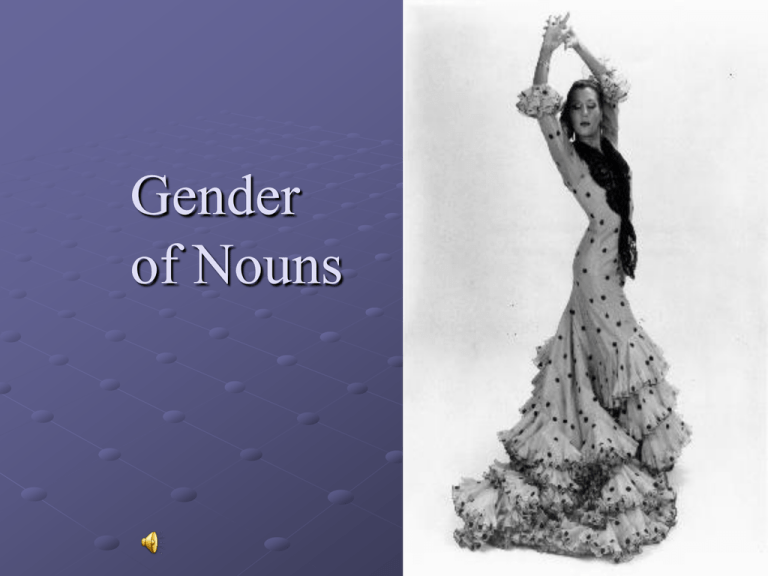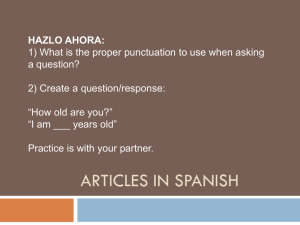Gender of Nouns
advertisement

Gender of Nouns A noun is a word used to denote a person, place, thing, or idea. PERSON: John, girl, dentist PLACE: garden, university, Venezuela THING: book, car, tomato IDEA: liberty, despair, intelligence In Spanish, all nouns are either masculine or feminine. MA S C U L I N E F EMI N I N E el chico .......... boy la chica ......... girl el jardín ........ garden la uva ……. grape el miedo ....... Fear la libertad ...... liberty The idea that nouns have gender seems perfectly natural when the noun stands for a living creature. This is because in English, living creatures often have different names, depending upon whether they are male or female. MA S C U L I N E man tiger aviator F EMI N I N E woman tigress aviatrix The following Spanish nouns all denote living creatures. el gato ...... male cat la gata …..female cat el perro ...... male dog la perra ....female dog el chico ....... boy la chica ........ girl How are all of these masculine nouns alike? el gato el perro el chico el abuelo HINT: look at both the beginning and the ending of each word pair. How are all of these feminine nouns alike? la gata la perra la chica la abuela “El” and “la” both mean “the.” el chico (the boy) la chica (the girl) NOTE: These two words (el, la) are called “definite articles.” Un chico Una chica Un gato Una manzana Un and Una mean “a / an”, they are indefinite articles. What do you notice about the last letter of these nouns? MA S C U L I N E gato perro chico abuelo F EMI N I N E gata perra chica abuela Nouns that end in -o are usually masculine. Nouns that end in -a are usually feminine. Notice the word “usually!” There are exceptions to these two rules and you will soon be learning them. One cannot predict the gender of a noun that stands for a non-living thing. Try to predict whether the Spanish words for the following things are masculine or feminine: MA S C U L I N E book house money window OR F EMI N I N E ? One cannot predict the gender of a noun, except in the case of living creatures. Do not try to analyze the nature of the object, looking for some inherent masculinity or femininity. It won’t work! Take a guess. Do you think the Spanish word for “dress” is masculine or feminine? You might expect it to be feminine, since a dress is an article of clothing worn by females. Actually, the word for “dress” is a masculine word: el vestido Take another guess. Do you think the Spanish word for “necktie” is masculine or feminine? You might expect it to be masculine, since a necktie is an article of clothing worn by males. Actually, the word for “necktie” is a feminine word: la corbata Nouns that end in -sión, -ción, -dad, -tad, and -tud, are feminine. la decision= the decision la conversación= the conversation la habitación= the bedroom la ciudad= the city la Universidad= the university la libertad = liberty la actitud= the attitude la television= the television Nouns that end with “e” can go either way. They’re pretty wild like that. The Last Slide! When you learn a new noun, you should also learn its definite article (el, la). There are several reasons for this: • Because you cannot predict the gender of most nouns. Because not every noun that ends in -o is masculine, and not every noun that ends in -a is feminine. Because many nouns end in letters other than o or a. Because the definite article (el, la) is your clue as to whether a noun is masculine or feminine.










